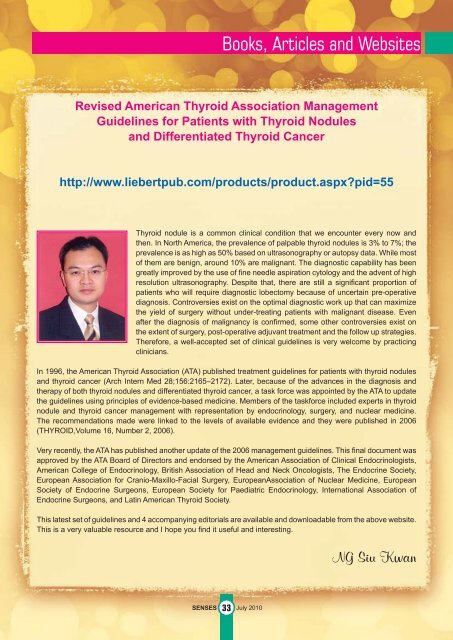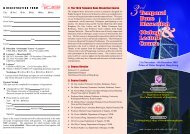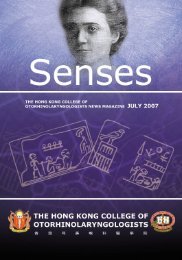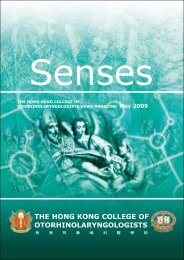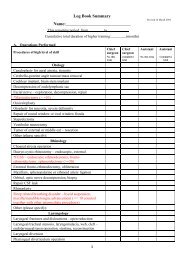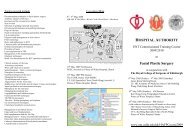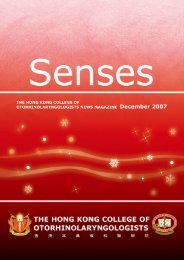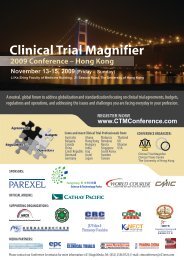Download - The Hong Kong College of Otorhinolaryngologists
Download - The Hong Kong College of Otorhinolaryngologists
Download - The Hong Kong College of Otorhinolaryngologists
You also want an ePaper? Increase the reach of your titles
YUMPU automatically turns print PDFs into web optimized ePapers that Google loves.
Books, Articles and Websites<br />
Revised American Thyroid Association Management<br />
Guidelines for Patients with Thyroid Nodules<br />
and Differentiated Thyroid Cancer<br />
http://www.liebertpub.com/products/product.aspxpid=55<br />
Thyroid nodule is a common clinical condition that we encounter every now and<br />
then. In North America, the prevalence <strong>of</strong> palpable thyroid nodules is 3% to 7%; the<br />
prevalence is as high as 50% based on ultrasonography or autopsy data. While most<br />
<strong>of</strong> them are benign, around 10% are malignant. <strong>The</strong> diagnostic capability has been<br />
greatly improved by the use <strong>of</strong> fine needle aspiration cytology and the advent <strong>of</strong> high<br />
resolution ultrasonography. Despite that, there are still a significant proportion <strong>of</strong><br />
patients who will require diagnostic lobectomy because <strong>of</strong> uncertain pre-operative<br />
diagnosis. Controversies exist on the optimal diagnostic work up that can maximize<br />
the yield <strong>of</strong> surgery without under-treating patients with malignant disease. Even<br />
after the diagnosis <strong>of</strong> malignancy is confirmed, some other controversies exist on<br />
the extent <strong>of</strong> surgery, post-operative adjuvant treatment and the follow up strategies.<br />
<strong>The</strong>refore, a well-accepted set <strong>of</strong> clinical guidelines is very welcome by practicing<br />
clinicians.<br />
In 1996, the American Thyroid Association (ATA) published treatment guidelines for patients with thyroid nodules<br />
and thyroid cancer (Arch Intern Med 28;156:2165–2172). Later, because <strong>of</strong> the advances in the diagnosis and<br />
therapy <strong>of</strong> both thyroid nodules and differentiated thyroid cancer, a task force was appointed by the ATA to update<br />
the guidelines using principles <strong>of</strong> evidence-based medicine. Members <strong>of</strong> the taskforce included experts in thyroid<br />
nodule and thyroid cancer management with representation by endocrinology, surgery, and nuclear medicine.<br />
<strong>The</strong> recommendations made were linked to the levels <strong>of</strong> available evidence and they were published in 2006<br />
(THYROID,Volume 16, Number 2, 2006).<br />
Very recently, the ATA has published another update <strong>of</strong> the 2006 management guidelines. This final document was<br />
approved by the ATA Board <strong>of</strong> Directors and endorsed by the American Association <strong>of</strong> Clinical Endocrinologists,<br />
American <strong>College</strong> <strong>of</strong> Endocrinology, British Association <strong>of</strong> Head and Neck Oncologists, <strong>The</strong> Endocrine Society,<br />
European Association for Cranio-Maxillo-Facial Surgery, EuropeanAssociation <strong>of</strong> Nuclear Medicine, European<br />
Society <strong>of</strong> Endocrine Surgeons, European Society for Paediatric Endocrinology, International Association <strong>of</strong><br />
Endocrine Surgeons, and Latin American Thyroid Society.<br />
This latest set <strong>of</strong> guidelines and 4 accompanying editorials are available and downloadable from the above website.<br />
This is a very valuable resource and I hope you find it useful and interesting.<br />
NG Siu Kwan<br />
33<br />
SENSES July 2010


